Marketing Communications in the Digital Age - Octopus Energy Case Study
VerifiedAdded on 2023/06/18
|8
|1990
|469
AI Summary
This report discusses the marketing strategies and communication model used by Octopus Energy, a UK-based renewable energy company, to promote their sustainable energy services. It covers the company's overview, vision and mission, objectives, STP, marketing mix, and communication model. The report concludes that effective marketing strategies and communication play a vital role in promoting a company's products or services.
Contribute Materials
Your contribution can guide someone’s learning journey. Share your
documents today.
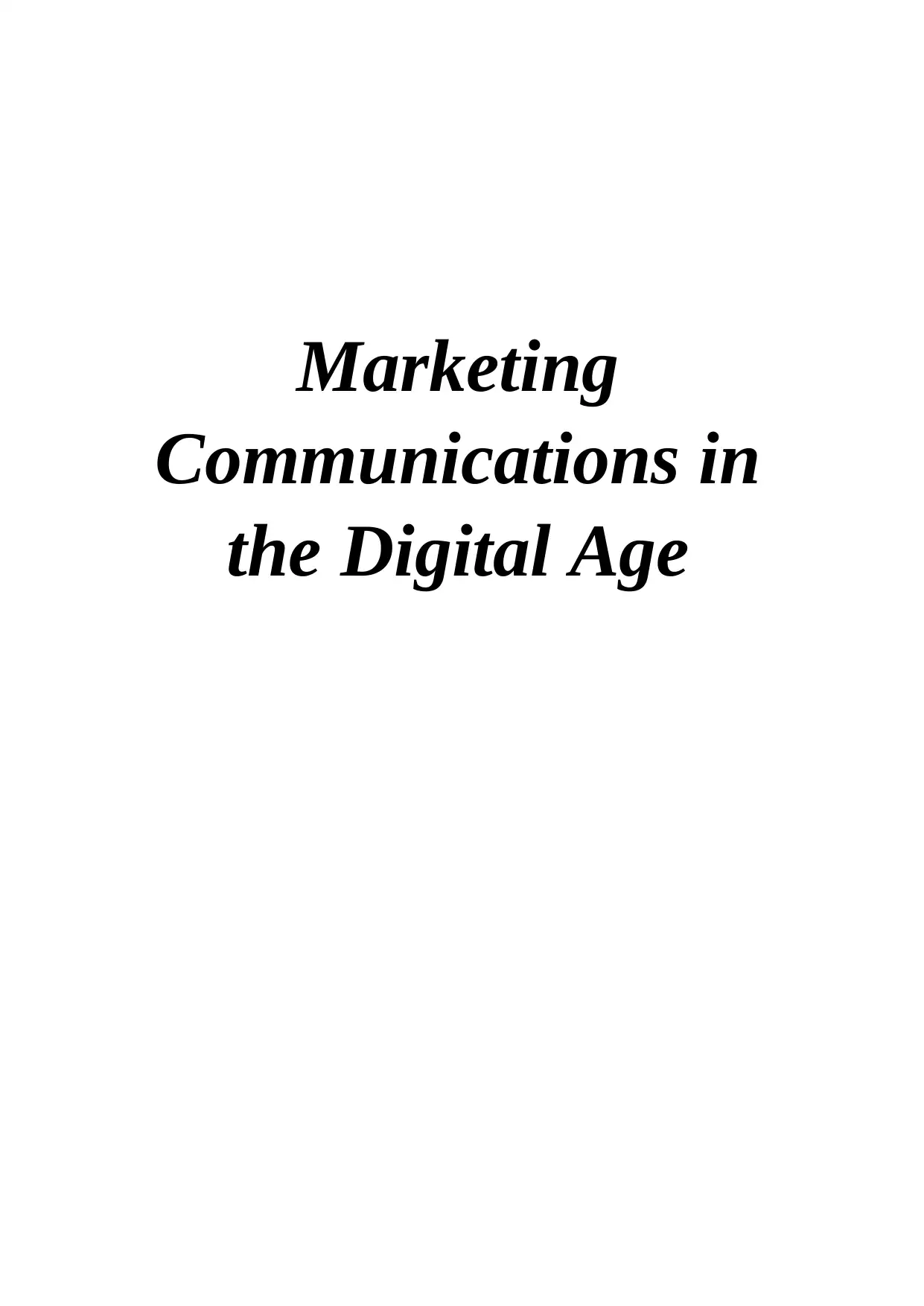
Marketing
Communications in
the Digital Age
Communications in
the Digital Age
Secure Best Marks with AI Grader
Need help grading? Try our AI Grader for instant feedback on your assignments.
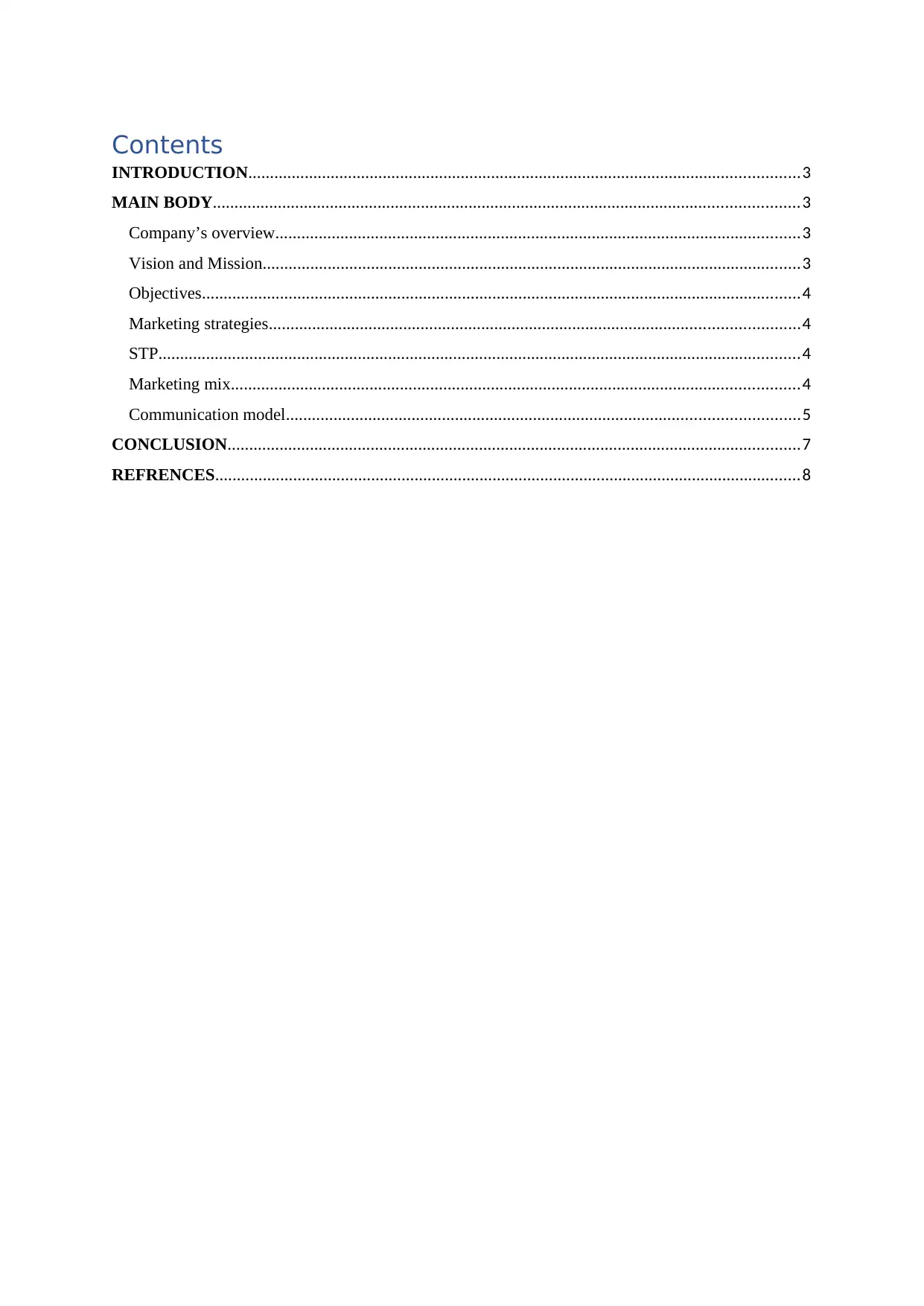
Contents
INTRODUCTION...............................................................................................................................3
MAIN BODY.......................................................................................................................................3
Company’s overview.........................................................................................................................3
Vision and Mission............................................................................................................................3
Objectives..........................................................................................................................................4
Marketing strategies..........................................................................................................................4
STP....................................................................................................................................................4
Marketing mix...................................................................................................................................4
Communication model......................................................................................................................5
CONCLUSION....................................................................................................................................7
REFRENCES.......................................................................................................................................8
INTRODUCTION...............................................................................................................................3
MAIN BODY.......................................................................................................................................3
Company’s overview.........................................................................................................................3
Vision and Mission............................................................................................................................3
Objectives..........................................................................................................................................4
Marketing strategies..........................................................................................................................4
STP....................................................................................................................................................4
Marketing mix...................................................................................................................................4
Communication model......................................................................................................................5
CONCLUSION....................................................................................................................................7
REFRENCES.......................................................................................................................................8
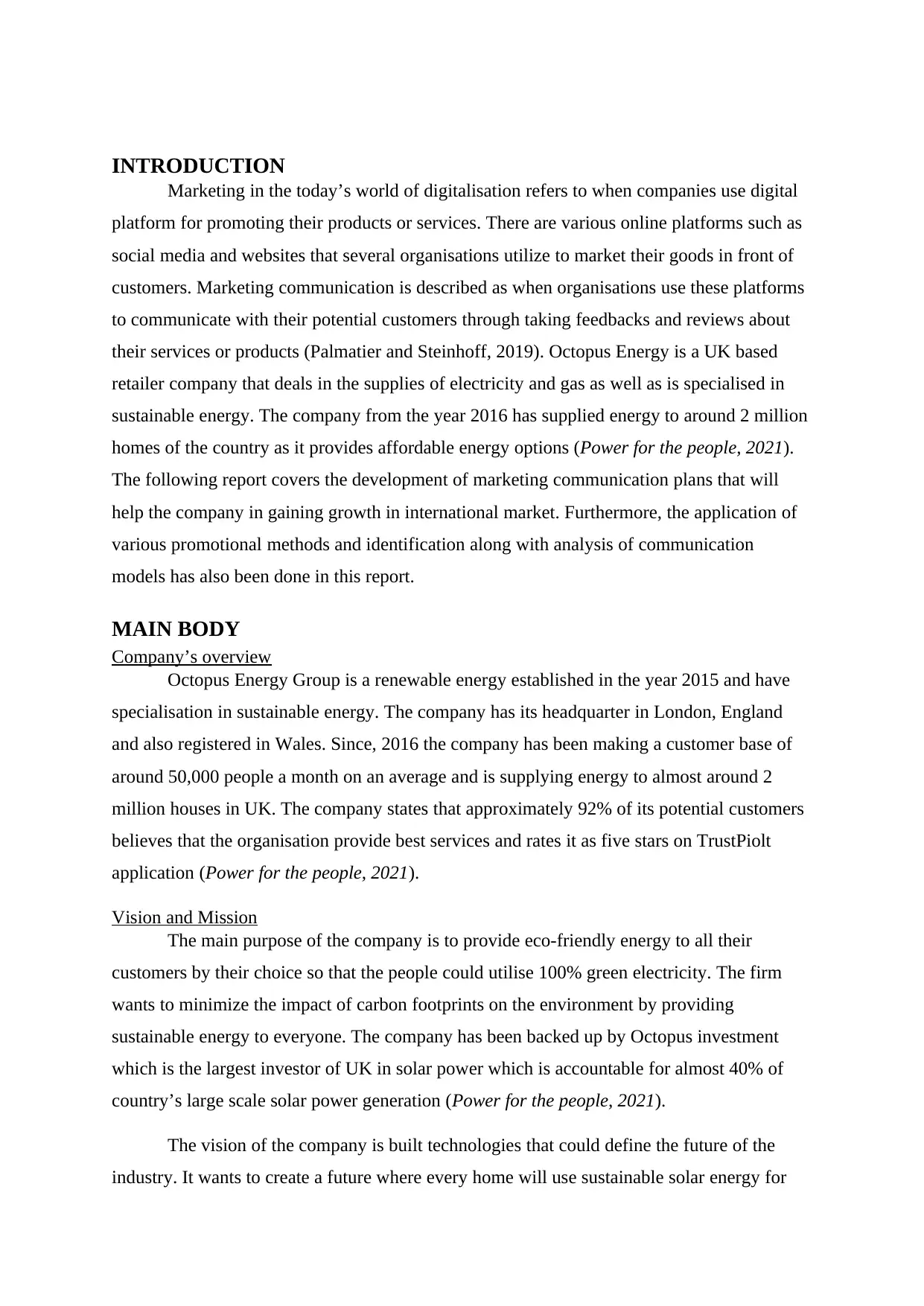
INTRODUCTION
Marketing in the today’s world of digitalisation refers to when companies use digital
platform for promoting their products or services. There are various online platforms such as
social media and websites that several organisations utilize to market their goods in front of
customers. Marketing communication is described as when organisations use these platforms
to communicate with their potential customers through taking feedbacks and reviews about
their services or products (Palmatier and Steinhoff, 2019). Octopus Energy is a UK based
retailer company that deals in the supplies of electricity and gas as well as is specialised in
sustainable energy. The company from the year 2016 has supplied energy to around 2 million
homes of the country as it provides affordable energy options (Power for the people, 2021).
The following report covers the development of marketing communication plans that will
help the company in gaining growth in international market. Furthermore, the application of
various promotional methods and identification along with analysis of communication
models has also been done in this report.
MAIN BODY
Company’s overview
Octopus Energy Group is a renewable energy established in the year 2015 and have
specialisation in sustainable energy. The company has its headquarter in London, England
and also registered in Wales. Since, 2016 the company has been making a customer base of
around 50,000 people a month on an average and is supplying energy to almost around 2
million houses in UK. The company states that approximately 92% of its potential customers
believes that the organisation provide best services and rates it as five stars on TrustPiolt
application (Power for the people, 2021).
Vision and Mission
The main purpose of the company is to provide eco-friendly energy to all their
customers by their choice so that the people could utilise 100% green electricity. The firm
wants to minimize the impact of carbon footprints on the environment by providing
sustainable energy to everyone. The company has been backed up by Octopus investment
which is the largest investor of UK in solar power which is accountable for almost 40% of
country’s large scale solar power generation (Power for the people, 2021).
The vision of the company is built technologies that could define the future of the
industry. It wants to create a future where every home will use sustainable solar energy for
Marketing in the today’s world of digitalisation refers to when companies use digital
platform for promoting their products or services. There are various online platforms such as
social media and websites that several organisations utilize to market their goods in front of
customers. Marketing communication is described as when organisations use these platforms
to communicate with their potential customers through taking feedbacks and reviews about
their services or products (Palmatier and Steinhoff, 2019). Octopus Energy is a UK based
retailer company that deals in the supplies of electricity and gas as well as is specialised in
sustainable energy. The company from the year 2016 has supplied energy to around 2 million
homes of the country as it provides affordable energy options (Power for the people, 2021).
The following report covers the development of marketing communication plans that will
help the company in gaining growth in international market. Furthermore, the application of
various promotional methods and identification along with analysis of communication
models has also been done in this report.
MAIN BODY
Company’s overview
Octopus Energy Group is a renewable energy established in the year 2015 and have
specialisation in sustainable energy. The company has its headquarter in London, England
and also registered in Wales. Since, 2016 the company has been making a customer base of
around 50,000 people a month on an average and is supplying energy to almost around 2
million houses in UK. The company states that approximately 92% of its potential customers
believes that the organisation provide best services and rates it as five stars on TrustPiolt
application (Power for the people, 2021).
Vision and Mission
The main purpose of the company is to provide eco-friendly energy to all their
customers by their choice so that the people could utilise 100% green electricity. The firm
wants to minimize the impact of carbon footprints on the environment by providing
sustainable energy to everyone. The company has been backed up by Octopus investment
which is the largest investor of UK in solar power which is accountable for almost 40% of
country’s large scale solar power generation (Power for the people, 2021).
The vision of the company is built technologies that could define the future of the
industry. It wants to create a future where every home will use sustainable solar energy for
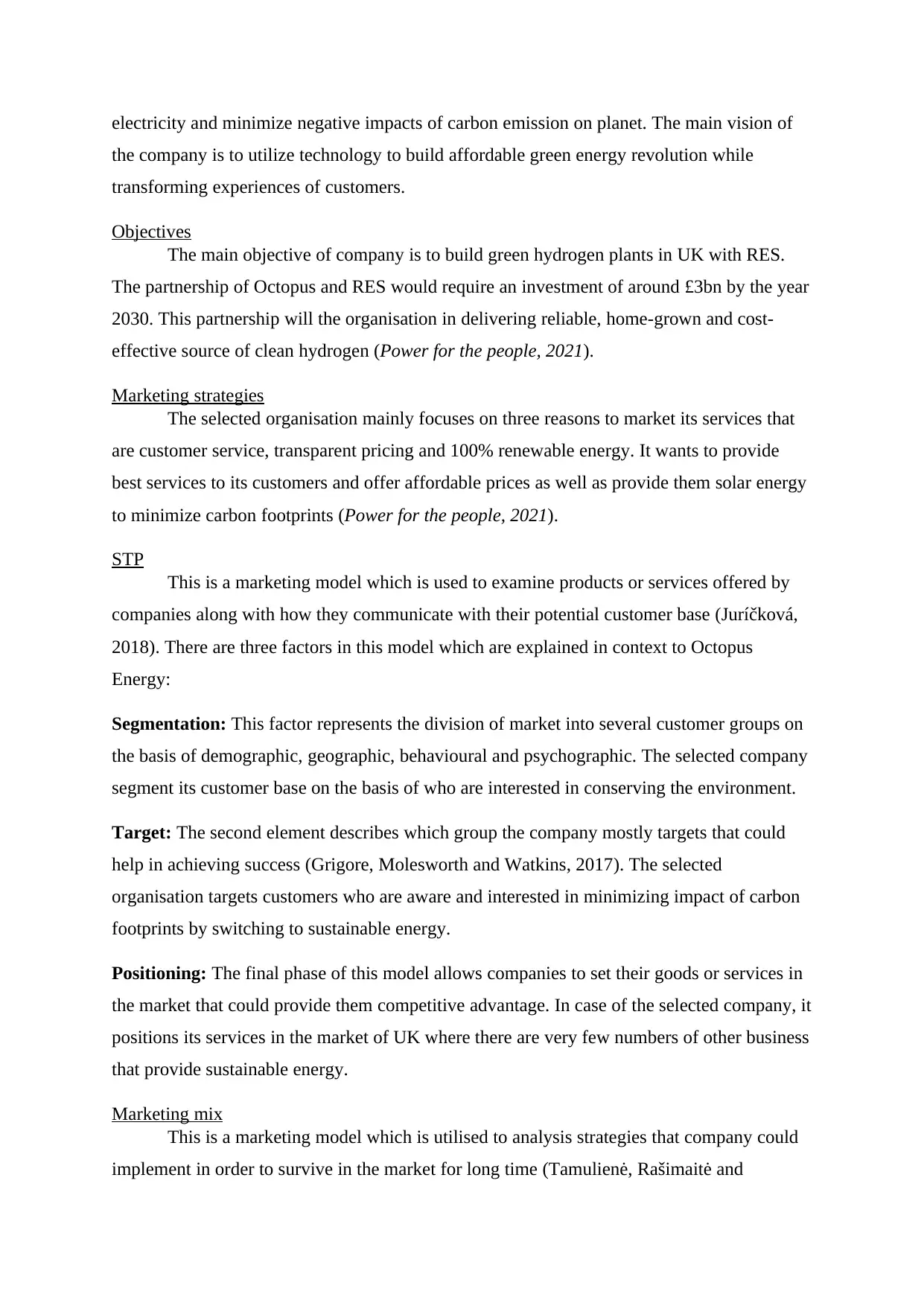
electricity and minimize negative impacts of carbon emission on planet. The main vision of
the company is to utilize technology to build affordable green energy revolution while
transforming experiences of customers.
Objectives
The main objective of company is to build green hydrogen plants in UK with RES.
The partnership of Octopus and RES would require an investment of around £3bn by the year
2030. This partnership will the organisation in delivering reliable, home-grown and cost-
effective source of clean hydrogen (Power for the people, 2021).
Marketing strategies
The selected organisation mainly focuses on three reasons to market its services that
are customer service, transparent pricing and 100% renewable energy. It wants to provide
best services to its customers and offer affordable prices as well as provide them solar energy
to minimize carbon footprints (Power for the people, 2021).
STP
This is a marketing model which is used to examine products or services offered by
companies along with how they communicate with their potential customer base (Juríčková,
2018). There are three factors in this model which are explained in context to Octopus
Energy:
Segmentation: This factor represents the division of market into several customer groups on
the basis of demographic, geographic, behavioural and psychographic. The selected company
segment its customer base on the basis of who are interested in conserving the environment.
Target: The second element describes which group the company mostly targets that could
help in achieving success (Grigore, Molesworth and Watkins, 2017). The selected
organisation targets customers who are aware and interested in minimizing impact of carbon
footprints by switching to sustainable energy.
Positioning: The final phase of this model allows companies to set their goods or services in
the market that could provide them competitive advantage. In case of the selected company, it
positions its services in the market of UK where there are very few numbers of other business
that provide sustainable energy.
Marketing mix
This is a marketing model which is utilised to analysis strategies that company could
implement in order to survive in the market for long time (Tamulienė, Rašimaitė and
the company is to utilize technology to build affordable green energy revolution while
transforming experiences of customers.
Objectives
The main objective of company is to build green hydrogen plants in UK with RES.
The partnership of Octopus and RES would require an investment of around £3bn by the year
2030. This partnership will the organisation in delivering reliable, home-grown and cost-
effective source of clean hydrogen (Power for the people, 2021).
Marketing strategies
The selected organisation mainly focuses on three reasons to market its services that
are customer service, transparent pricing and 100% renewable energy. It wants to provide
best services to its customers and offer affordable prices as well as provide them solar energy
to minimize carbon footprints (Power for the people, 2021).
STP
This is a marketing model which is used to examine products or services offered by
companies along with how they communicate with their potential customer base (Juríčková,
2018). There are three factors in this model which are explained in context to Octopus
Energy:
Segmentation: This factor represents the division of market into several customer groups on
the basis of demographic, geographic, behavioural and psychographic. The selected company
segment its customer base on the basis of who are interested in conserving the environment.
Target: The second element describes which group the company mostly targets that could
help in achieving success (Grigore, Molesworth and Watkins, 2017). The selected
organisation targets customers who are aware and interested in minimizing impact of carbon
footprints by switching to sustainable energy.
Positioning: The final phase of this model allows companies to set their goods or services in
the market that could provide them competitive advantage. In case of the selected company, it
positions its services in the market of UK where there are very few numbers of other business
that provide sustainable energy.
Marketing mix
This is a marketing model which is utilised to analysis strategies that company could
implement in order to survive in the market for long time (Tamulienė, Rašimaitė and
Secure Best Marks with AI Grader
Need help grading? Try our AI Grader for instant feedback on your assignments.
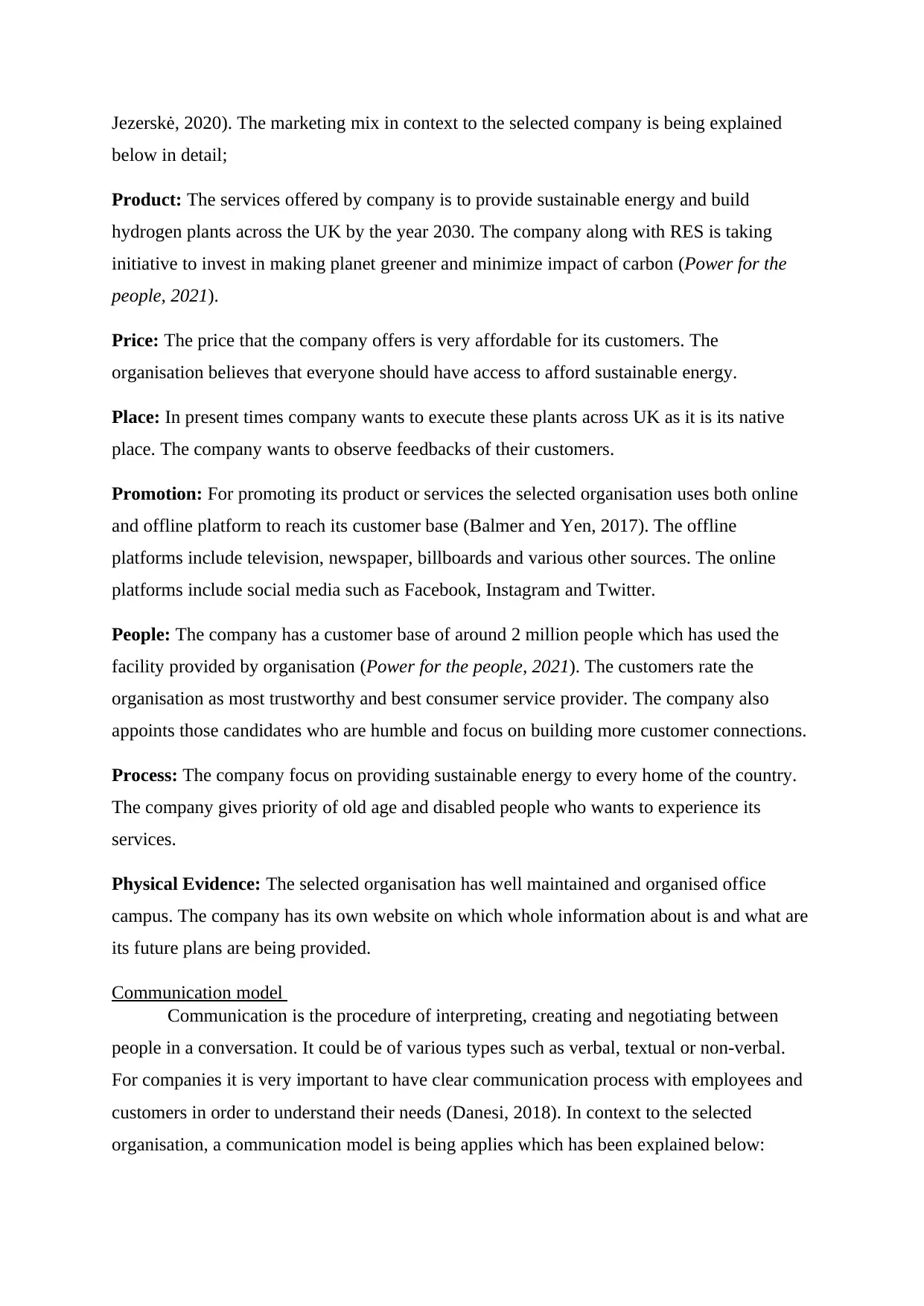
Jezerskė, 2020). The marketing mix in context to the selected company is being explained
below in detail;
Product: The services offered by company is to provide sustainable energy and build
hydrogen plants across the UK by the year 2030. The company along with RES is taking
initiative to invest in making planet greener and minimize impact of carbon (Power for the
people, 2021).
Price: The price that the company offers is very affordable for its customers. The
organisation believes that everyone should have access to afford sustainable energy.
Place: In present times company wants to execute these plants across UK as it is its native
place. The company wants to observe feedbacks of their customers.
Promotion: For promoting its product or services the selected organisation uses both online
and offline platform to reach its customer base (Balmer and Yen, 2017). The offline
platforms include television, newspaper, billboards and various other sources. The online
platforms include social media such as Facebook, Instagram and Twitter.
People: The company has a customer base of around 2 million people which has used the
facility provided by organisation (Power for the people, 2021). The customers rate the
organisation as most trustworthy and best consumer service provider. The company also
appoints those candidates who are humble and focus on building more customer connections.
Process: The company focus on providing sustainable energy to every home of the country.
The company gives priority of old age and disabled people who wants to experience its
services.
Physical Evidence: The selected organisation has well maintained and organised office
campus. The company has its own website on which whole information about is and what are
its future plans are being provided.
Communication model
Communication is the procedure of interpreting, creating and negotiating between
people in a conversation. It could be of various types such as verbal, textual or non-verbal.
For companies it is very important to have clear communication process with employees and
customers in order to understand their needs (Danesi, 2018). In context to the selected
organisation, a communication model is being applies which has been explained below:
below in detail;
Product: The services offered by company is to provide sustainable energy and build
hydrogen plants across the UK by the year 2030. The company along with RES is taking
initiative to invest in making planet greener and minimize impact of carbon (Power for the
people, 2021).
Price: The price that the company offers is very affordable for its customers. The
organisation believes that everyone should have access to afford sustainable energy.
Place: In present times company wants to execute these plants across UK as it is its native
place. The company wants to observe feedbacks of their customers.
Promotion: For promoting its product or services the selected organisation uses both online
and offline platform to reach its customer base (Balmer and Yen, 2017). The offline
platforms include television, newspaper, billboards and various other sources. The online
platforms include social media such as Facebook, Instagram and Twitter.
People: The company has a customer base of around 2 million people which has used the
facility provided by organisation (Power for the people, 2021). The customers rate the
organisation as most trustworthy and best consumer service provider. The company also
appoints those candidates who are humble and focus on building more customer connections.
Process: The company focus on providing sustainable energy to every home of the country.
The company gives priority of old age and disabled people who wants to experience its
services.
Physical Evidence: The selected organisation has well maintained and organised office
campus. The company has its own website on which whole information about is and what are
its future plans are being provided.
Communication model
Communication is the procedure of interpreting, creating and negotiating between
people in a conversation. It could be of various types such as verbal, textual or non-verbal.
For companies it is very important to have clear communication process with employees and
customers in order to understand their needs (Danesi, 2018). In context to the selected
organisation, a communication model is being applies which has been explained below:
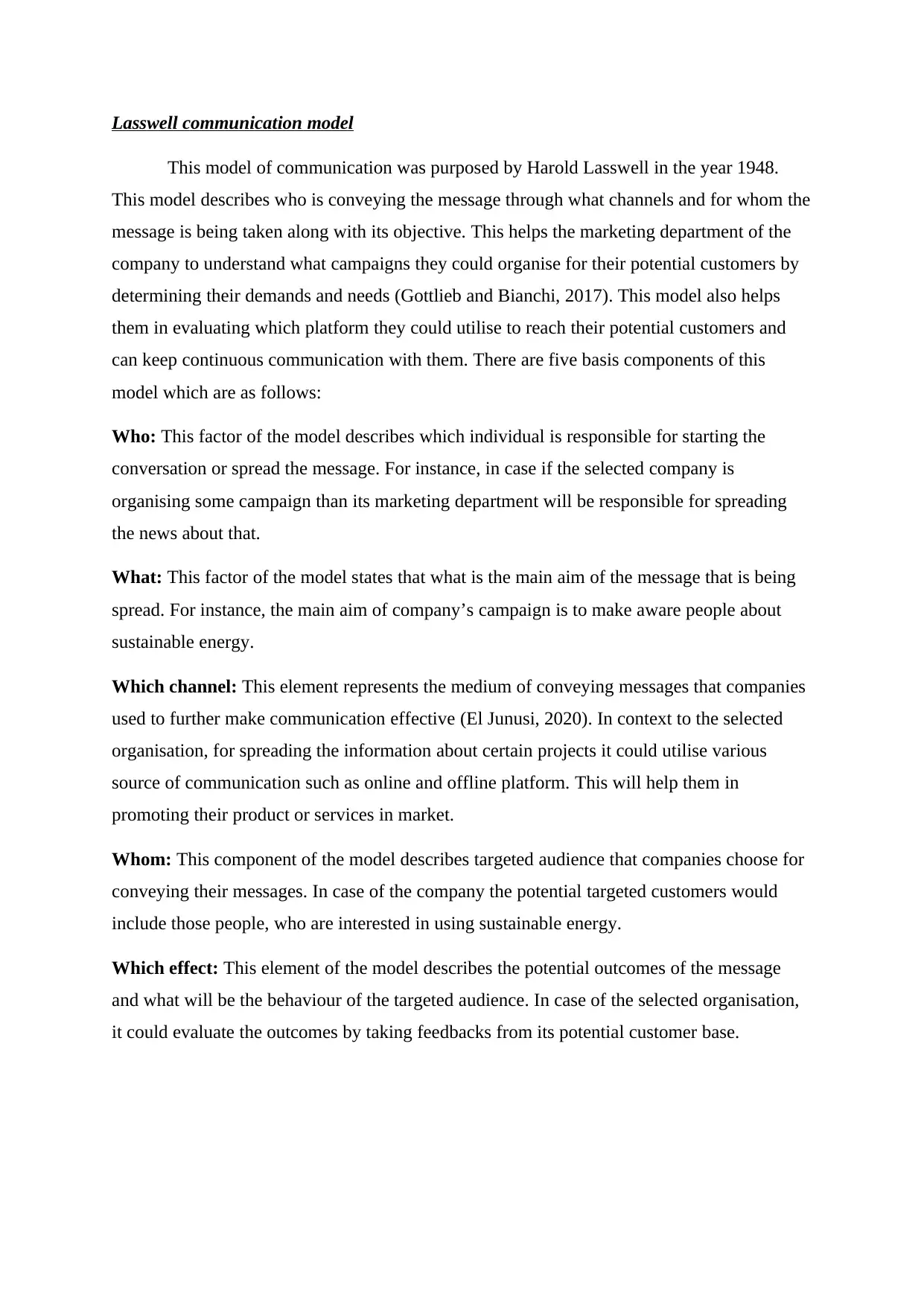
Lasswell communication model
This model of communication was purposed by Harold Lasswell in the year 1948.
This model describes who is conveying the message through what channels and for whom the
message is being taken along with its objective. This helps the marketing department of the
company to understand what campaigns they could organise for their potential customers by
determining their demands and needs (Gottlieb and Bianchi, 2017). This model also helps
them in evaluating which platform they could utilise to reach their potential customers and
can keep continuous communication with them. There are five basis components of this
model which are as follows:
Who: This factor of the model describes which individual is responsible for starting the
conversation or spread the message. For instance, in case if the selected company is
organising some campaign than its marketing department will be responsible for spreading
the news about that.
What: This factor of the model states that what is the main aim of the message that is being
spread. For instance, the main aim of company’s campaign is to make aware people about
sustainable energy.
Which channel: This element represents the medium of conveying messages that companies
used to further make communication effective (El Junusi, 2020). In context to the selected
organisation, for spreading the information about certain projects it could utilise various
source of communication such as online and offline platform. This will help them in
promoting their product or services in market.
Whom: This component of the model describes targeted audience that companies choose for
conveying their messages. In case of the company the potential targeted customers would
include those people, who are interested in using sustainable energy.
Which effect: This element of the model describes the potential outcomes of the message
and what will be the behaviour of the targeted audience. In case of the selected organisation,
it could evaluate the outcomes by taking feedbacks from its potential customer base.
This model of communication was purposed by Harold Lasswell in the year 1948.
This model describes who is conveying the message through what channels and for whom the
message is being taken along with its objective. This helps the marketing department of the
company to understand what campaigns they could organise for their potential customers by
determining their demands and needs (Gottlieb and Bianchi, 2017). This model also helps
them in evaluating which platform they could utilise to reach their potential customers and
can keep continuous communication with them. There are five basis components of this
model which are as follows:
Who: This factor of the model describes which individual is responsible for starting the
conversation or spread the message. For instance, in case if the selected company is
organising some campaign than its marketing department will be responsible for spreading
the news about that.
What: This factor of the model states that what is the main aim of the message that is being
spread. For instance, the main aim of company’s campaign is to make aware people about
sustainable energy.
Which channel: This element represents the medium of conveying messages that companies
used to further make communication effective (El Junusi, 2020). In context to the selected
organisation, for spreading the information about certain projects it could utilise various
source of communication such as online and offline platform. This will help them in
promoting their product or services in market.
Whom: This component of the model describes targeted audience that companies choose for
conveying their messages. In case of the company the potential targeted customers would
include those people, who are interested in using sustainable energy.
Which effect: This element of the model describes the potential outcomes of the message
and what will be the behaviour of the targeted audience. In case of the selected organisation,
it could evaluate the outcomes by taking feedbacks from its potential customer base.
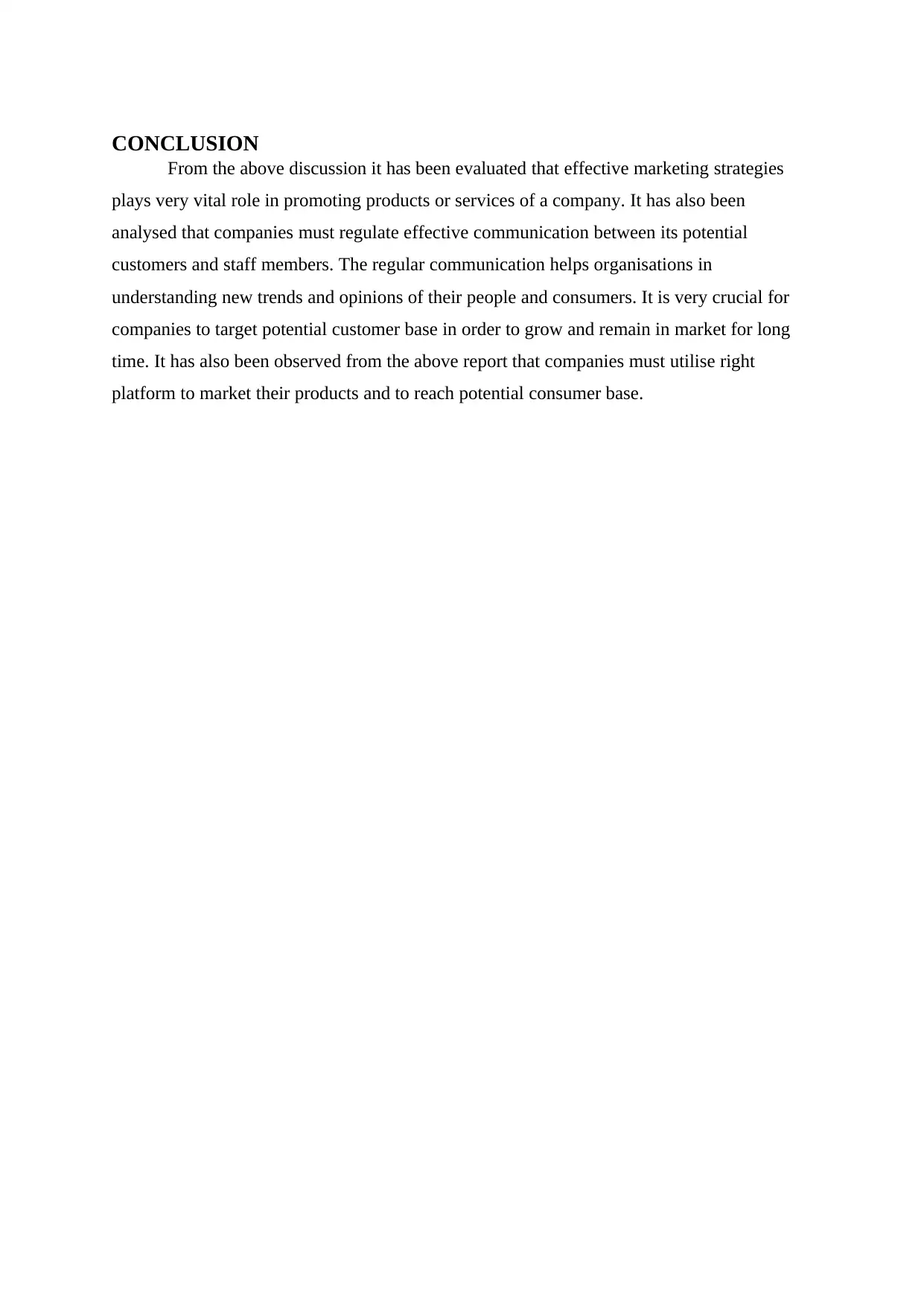
CONCLUSION
From the above discussion it has been evaluated that effective marketing strategies
plays very vital role in promoting products or services of a company. It has also been
analysed that companies must regulate effective communication between its potential
customers and staff members. The regular communication helps organisations in
understanding new trends and opinions of their people and consumers. It is very crucial for
companies to target potential customer base in order to grow and remain in market for long
time. It has also been observed from the above report that companies must utilise right
platform to market their products and to reach potential consumer base.
From the above discussion it has been evaluated that effective marketing strategies
plays very vital role in promoting products or services of a company. It has also been
analysed that companies must regulate effective communication between its potential
customers and staff members. The regular communication helps organisations in
understanding new trends and opinions of their people and consumers. It is very crucial for
companies to target potential customer base in order to grow and remain in market for long
time. It has also been observed from the above report that companies must utilise right
platform to market their products and to reach potential consumer base.
Paraphrase This Document
Need a fresh take? Get an instant paraphrase of this document with our AI Paraphraser
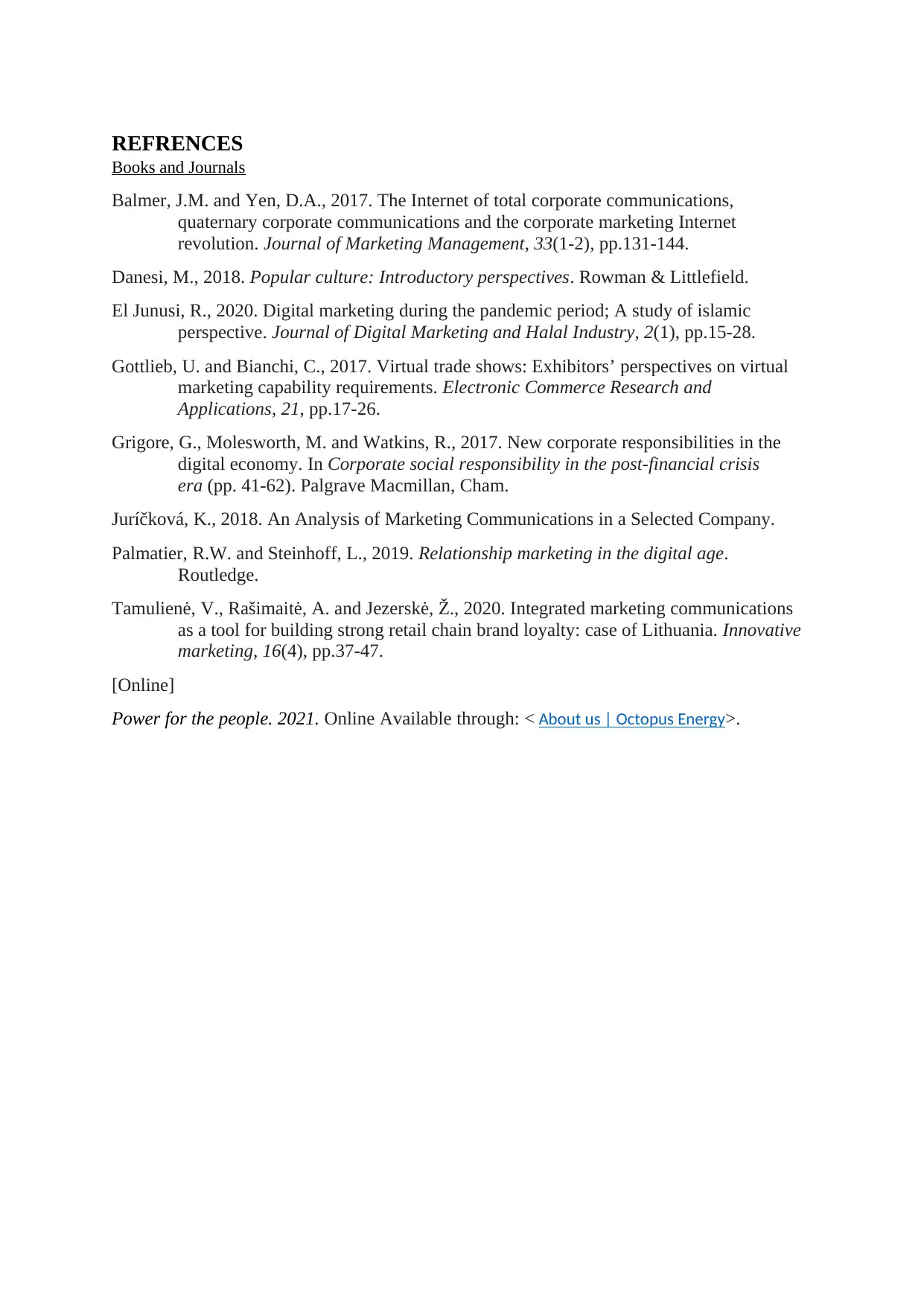
REFRENCES
Books and Journals
Balmer, J.M. and Yen, D.A., 2017. The Internet of total corporate communications,
quaternary corporate communications and the corporate marketing Internet
revolution. Journal of Marketing Management, 33(1-2), pp.131-144.
Danesi, M., 2018. Popular culture: Introductory perspectives. Rowman & Littlefield.
El Junusi, R., 2020. Digital marketing during the pandemic period; A study of islamic
perspective. Journal of Digital Marketing and Halal Industry, 2(1), pp.15-28.
Gottlieb, U. and Bianchi, C., 2017. Virtual trade shows: Exhibitors’ perspectives on virtual
marketing capability requirements. Electronic Commerce Research and
Applications, 21, pp.17-26.
Grigore, G., Molesworth, M. and Watkins, R., 2017. New corporate responsibilities in the
digital economy. In Corporate social responsibility in the post-financial crisis
era (pp. 41-62). Palgrave Macmillan, Cham.
Juríčková, K., 2018. An Analysis of Marketing Communications in a Selected Company.
Palmatier, R.W. and Steinhoff, L., 2019. Relationship marketing in the digital age.
Routledge.
Tamulienė, V., Rašimaitė, A. and Jezerskė, Ž., 2020. Integrated marketing communications
as a tool for building strong retail chain brand loyalty: case of Lithuania. Innovative
marketing, 16(4), pp.37-47.
[Online]
Power for the people. 2021. Online Available through: < About us | Octopus Energy>.
Books and Journals
Balmer, J.M. and Yen, D.A., 2017. The Internet of total corporate communications,
quaternary corporate communications and the corporate marketing Internet
revolution. Journal of Marketing Management, 33(1-2), pp.131-144.
Danesi, M., 2018. Popular culture: Introductory perspectives. Rowman & Littlefield.
El Junusi, R., 2020. Digital marketing during the pandemic period; A study of islamic
perspective. Journal of Digital Marketing and Halal Industry, 2(1), pp.15-28.
Gottlieb, U. and Bianchi, C., 2017. Virtual trade shows: Exhibitors’ perspectives on virtual
marketing capability requirements. Electronic Commerce Research and
Applications, 21, pp.17-26.
Grigore, G., Molesworth, M. and Watkins, R., 2017. New corporate responsibilities in the
digital economy. In Corporate social responsibility in the post-financial crisis
era (pp. 41-62). Palgrave Macmillan, Cham.
Juríčková, K., 2018. An Analysis of Marketing Communications in a Selected Company.
Palmatier, R.W. and Steinhoff, L., 2019. Relationship marketing in the digital age.
Routledge.
Tamulienė, V., Rašimaitė, A. and Jezerskė, Ž., 2020. Integrated marketing communications
as a tool for building strong retail chain brand loyalty: case of Lithuania. Innovative
marketing, 16(4), pp.37-47.
[Online]
Power for the people. 2021. Online Available through: < About us | Octopus Energy>.
1 out of 8
Related Documents
Your All-in-One AI-Powered Toolkit for Academic Success.
+13062052269
info@desklib.com
Available 24*7 on WhatsApp / Email
![[object Object]](/_next/static/media/star-bottom.7253800d.svg)
Unlock your academic potential
© 2024 | Zucol Services PVT LTD | All rights reserved.




